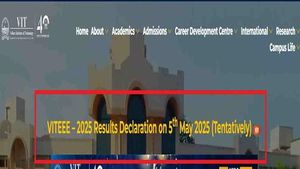The Indian Space Research Organisation (ISRO) marked another significant milestone with the successful launch of the European Space Agency's (ESA) Proba-3 mission on December 5, 2024. This thrilling event took place at the Satish Dhawan Space Centre located in Sriharikota, where ISRO utilized its trusted Polar Satellite Launch Vehicle (PSLV-C59) for the task.
Originally set to launch on December 4, the event faced a brief setback due to the detection of an anomaly within the satellite's propulsion system. Nevertheless, the ISRO team managed to reschedule the launch with precision, eventually lifting off at 4:04 PM IST (1034 GMT). Shortly thereafter, ISRO officials reported a flawless deployment of the satellites.
Proba-3, which stands for Project for Onboard Autonomy, consists of two intricately coordinated satellites: the Coronagraph Spacecraft (CSC), weighing approximately 310 kg, and the Occulter Spacecraft (OSC), at about 240 kg. This mission isn't just important for its scientific objectives but also for demonstrating cutting-edge technological advancement. The two satellites will fly together, maintaining a steady distance of 150 meters apart as they mimic the actions of one single observational platform.
By working together, these satellites will create artificial solar eclipses, enabling continuous observation of the Sun's corona — its outer atmosphere known for being significantly hotter than the Sun's surface. This super-heated region, often overlooked, plays a pivotal role in the dynamics of solar activity such as solar flares and coronal mass ejections, which can disrupt satellite communications and impact power systems on Earth.
ESA's ambitious Proba-3 mission is projected to span two years, during which the satellites will operate within an elliptical orbit, positioning them close to the solar limb for about six hours every orbit. This extended observation time far exceeds the brief duration of natural solar eclipses, which occur only about 60 times every century.
"The primary goal of the Proba-3 mission is to investigate the Sun's corona with unprecedented accuracy," stated Proba-3 Systems Engineer, Esther Bastida Pertegaz, emphasizing the need to explore how solar phenomena such as coronal mass ejections originate. These observations, she noted, are pivotal for enhancing our comprehension of solar weather, thereby aiding scientists worldwide.
The mission's scientific equipment includes the ASPIICS (Association of Spacecraft for Polarimetric and Imaging Investigation of Corona of the Sun), which is carried aboard the CSC. This instrument is uniquely crafted to capture highly detailed images of the solar corona, turning theoretical study points of solar behavior and needs of both academic research and commercial applications.
Josef Atchbacher, ESA's Director General, expressed enthusiasm over the successful launch, highlighting its significance as not merely another flight but as part of the larger narrative of space exploration collaboration between ISRO and ESA. The partnership demonstrates thorough coordination and the sharing of expertise, making significant strides for both organizations.
Notably, this launch is remarkable for ISRO as it signifies the 61st flight of the PSLV and its 26th mission utilizing the PSLV-XL configuration, showcasing its consistent reliability as a medium-lift launch vehicle set to meet international demands.
The mission also reinforces ISRO's ambition to position itself as a prominent commercial launch provider on the global stage. While progressing with its lunar and planetary exploration efforts, including missions to the Moon, Mars, and Venus, ISRO's collaboration with ESA on Proba-3 embodies the rising global reliance on Indian capabilities.
While Proba-3 is dedicated to studying solar phenomena, the mission simultaneously involves participation from over 40 European firms, such as SENER Aerospace, Redwire Space, and Airbus Defence and Space, dedicated to creating innovative solutions to understand and predict space weather effectively.
All eyes are inevitably focused on the data this mission will yield. The insights gleaned from the Proba-3 mission seem poised to impact science, engineering, and commercial enterprises related to space technology, supporting continued exploration and observation. Scientists worldwide are eager for the mission's operational phase, which he anticipates starting early next year 2025.
The successful integration of advanced technologies and international collaboration showcased by the Proba-3 mission serves as evidence of how space agencies can optimize their resources and expertise for more comprehensive scientific exploration and advancement.
All this sets the stage for enhanced observation of solar activities and the implications of such activities on earth, keeping humanity informed of potential risks and the need for preparedness against adverse space weather.



